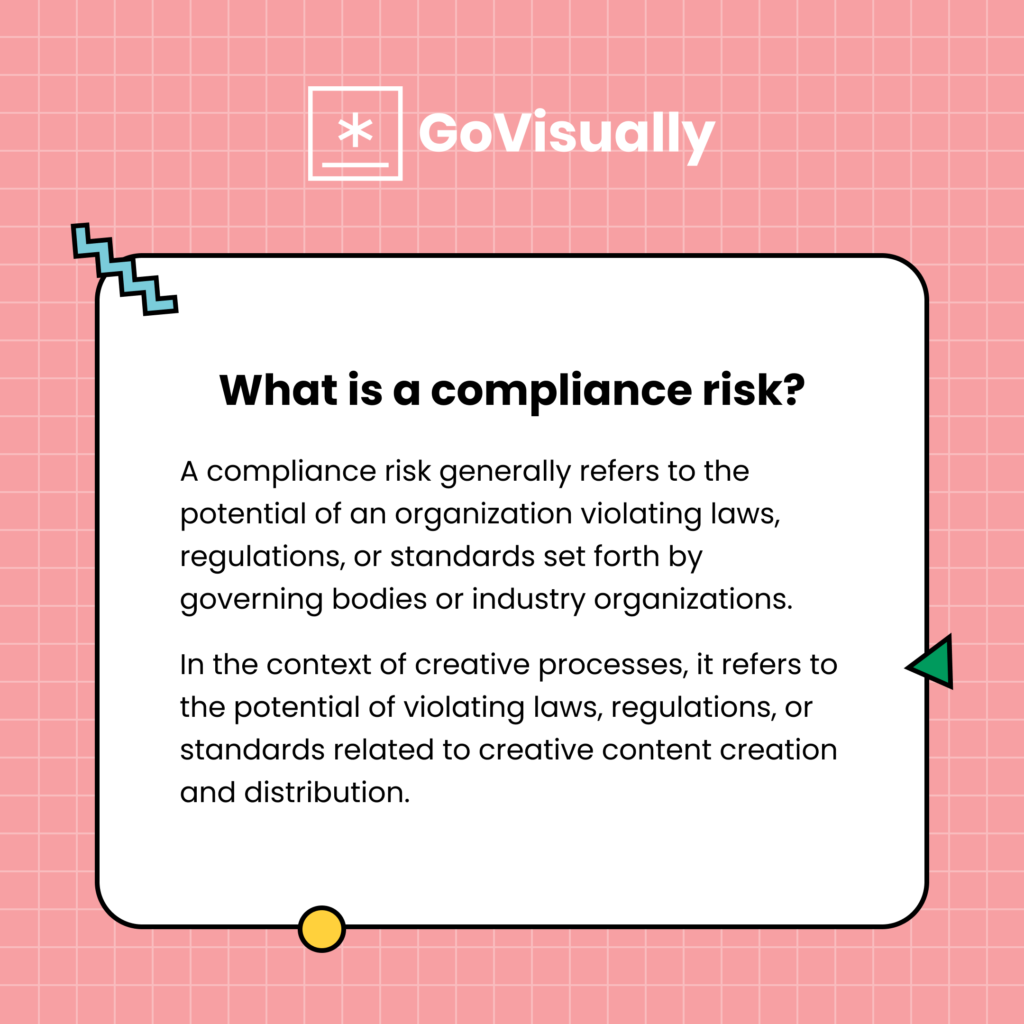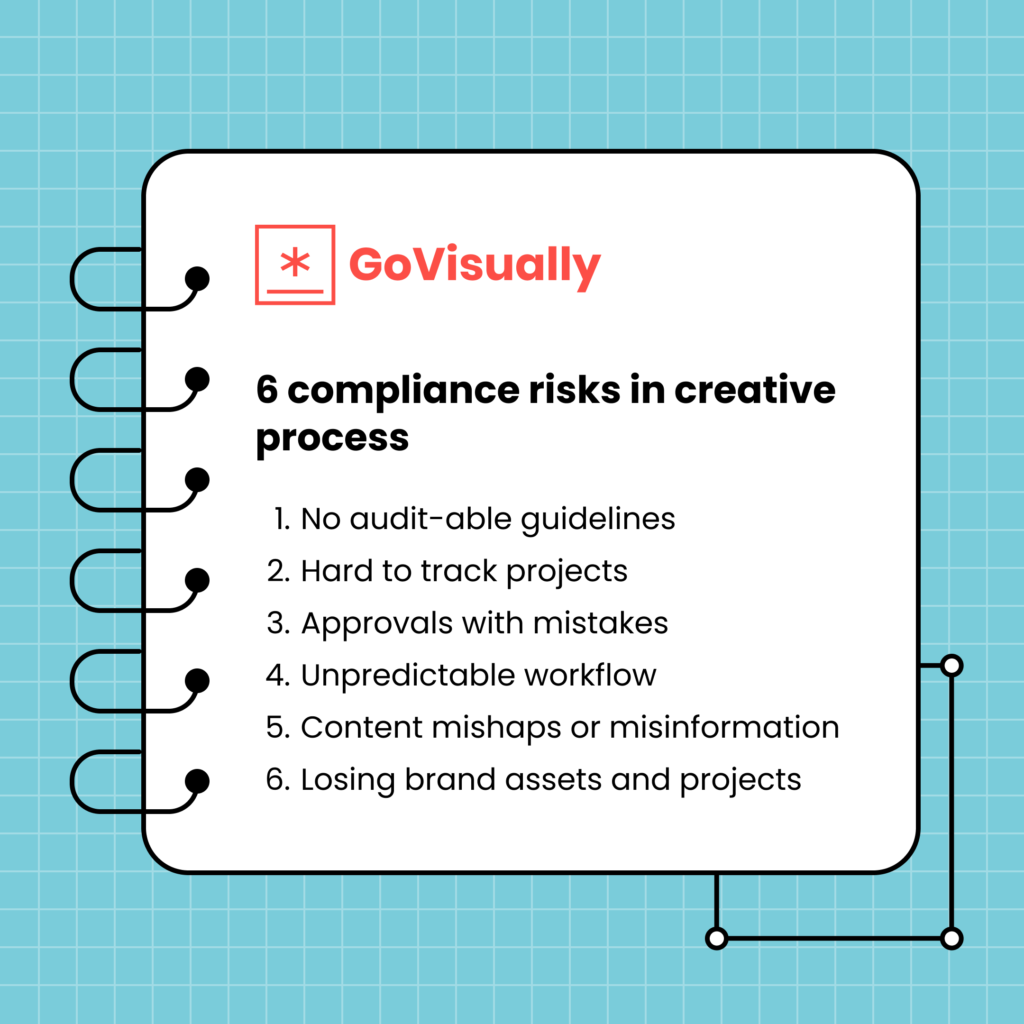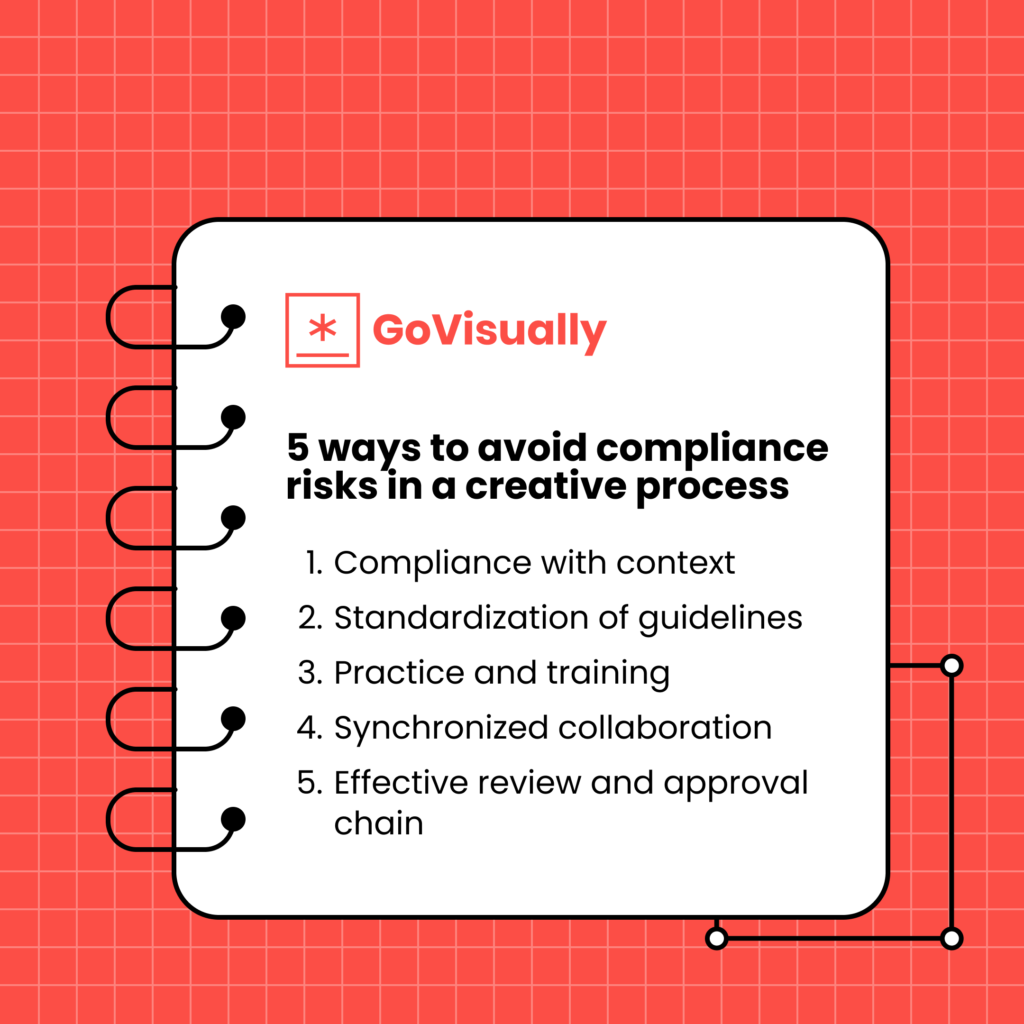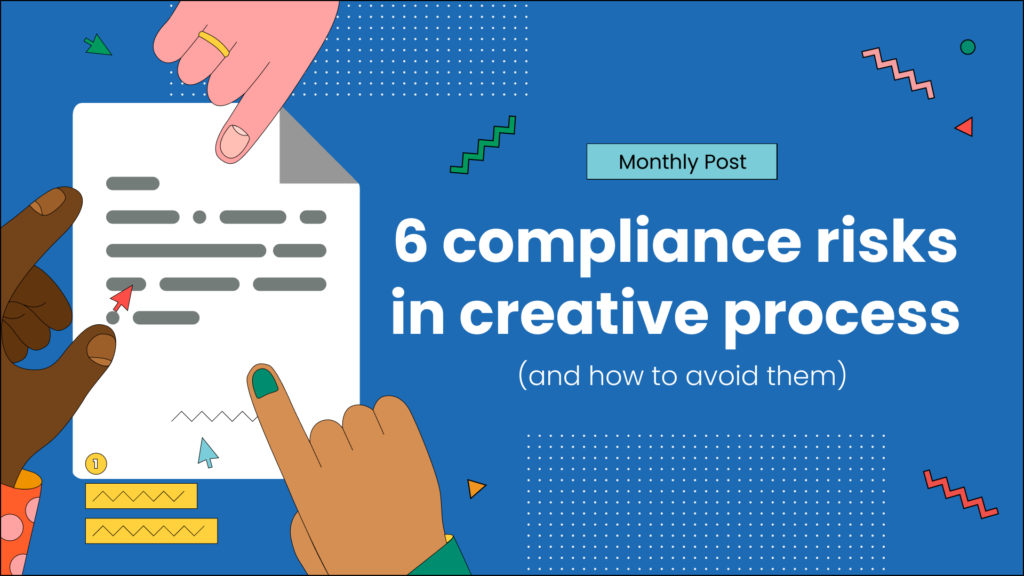Are you aware of all the compliance risks lurking in your creative process?
Well, compliance and creativity are often seen as two opposing concepts.
There are no rules in creativity, after all.
However, compliance management becomes absolutely crucial if you’re a professional working in this boundless industry. Non-compliant content can result in hefty fines, legal battles, and even damage to your brand reputation.
70% of companies consider compliance a top business priority, yet only 30% feel they have effective compliance programs.
This discrepancy can be especially concerning for organizations involved in the creative process, where compliance risks are prevalent and difficult to manage.
We’re sure you’re feeling just as lost as we once did.
So today, we’ll explore the potential pitfalls that can threaten the compliance of your creative content and actionable strategies and tools to mitigate these risks and build a risk-free creative process.
Let’s dive in!
Table of Contents
What is a compliance risk?
A compliance risk generally refers to the potential of an organization violating laws, regulations, or standards set forth by governing bodies or industry organizations.

Compliance risks can arise from various factors, including failure to adhere to policies and procedures, lack of employee training and awareness, and inadequate monitoring of operations.
While compliance management is widespread in all industries and businesses, it works and impacts the creative world differently.
What are compliance risks in creativity?
In the context of creative processes, it refers to the potential of violating laws, regulations, or standards related to creative content creation and distribution.
In the creative industry, compliance risks can arise from various factors, including intellectual property infringement, data privacy violations, misleading advertising, non-compliant content, discriminatory content, social media mishaps, and lack of accessibility.
These seem obvious but can be easily overlooked amidst a messy workflow. Such compliance risks can result in legal and reputational consequences for organizations and negative impacts on their stakeholders.
6 compliance risks in creative process
Compliance risks in the creative process can significantly threaten a company’s reputation, productivity, employee retention, and financial well-being.
Here are the 6 major risks of poor compliance processes for your creative business:

1. No auditable guidelines
Creatives are normal people at the end of the day, and normal people forget things.
Auditable guidelines can help ensure that marketing and promotional materials meet compliance requirements and provide a clear approval process record in case of an audit or investigation.
But the absence of such can lead to several problems. For example, an influencer partnering with a brand to promote a product without disclosing that it is a paid advertisement. Without clear guidelines for disclosures and proper monitoring, the brand may face penalties and damage its reputation.
Do Not only auditable guidelines help your team remember compliance guidelines like a checklist of sorts, but they also enable third-party collaboration with clear terms of work and retain your reputation, value, and, most of all, money!
2. Hard to track projects
When projects are hard to track, it can lead to a lack of visibility and control over the creative process. This can result in missed deadlines, duplication of effort, and even project failure.
This is especially true when your team uses a messy email thread for review and approvals in remote or in-house teams.
For instance, in 2020, Cyberpunk 2077, a highly anticipated video game, was released with numerous bugs and glitches that could have been caught and fixed with more thorough tracking and management of the creative process. It resulted in widespread criticism from gamers and industry experts alike.
3. Approvals with mistakes
Approvals with mistakes can occur when there is a lack of clarity, or the approval process is not standardized. This can result in losing the audience, brand reputation, and revenue.
For example, the most common content mistake that can cost you money is printing the wrong merchandise design or advertisement pamphlets in bulk. Imagine the capital that went into printing and the loss of having it all wrong.
This happened at the 2022 Platinum Jubilee for Queen Elizabeth, where her merchandise got widely critiqued after a small typo. It was meme-worthy, but the royal family’s compliance management process needs improvement.
4. Unpredictable workflow
An unpredictable workflow can result in delays, confusion, and errors in the creative process. This can lead to missed deadlines, low-quality work, and legal liabilities.
Suppose your team has to keep track of 40 different email threads on new changes over a creative project, report to 5 different people separately, and pass every version to another team member for approval. In that case, there are bound to be mistaken. A lot of them.
Add unpredictable deadlines, reviews, and client feedback to the mix, and you have a disastrous workflow that won’t last your business a day more.
If this sounds exaggerated, it’s not. Because the scenario we painted above is often true for many creative professionals due to a lack of compliance.
5. Content mishaps or misinformation
Content mishaps due to an unclear compliance process can be quite damaging for a brand, as they can potentially result in legal action, negative publicity, and loss of consumer trust.
Hundreds of brands, some very popular, have faced backlash due to very controversial content on their social media, websites, and ad campaigns. A particularly recent example is Balenciaga’s photoshoot scandal.
It involved accusations of exploitation and inappropriate treatment of child models during a photo shoot for the luxury fashion brand’s winter 2022 campaign. Yet the brand apologized, highlighting how they sourced a third-party service and errors in their compliance process resulted in releasing such material when it should’ve been rejected.
The brand faced millions of dollars in loss in hours!
6. Losing brand assets and projects
Does your team frequently ask for the same documents, brand design assets, and content direction even after you’ve sent them?
Losing brand assets is common for creatives when there are no compliance terms to tackle asset management for creative teams. And yes, this, too, happens to the best of us!
In 2010, Gap redesigned its logo and attempted to launch it on its website without any announcement. The public reaction was overwhelmingly negative, and Gap quickly reverted to its old logo.
However, during this process, they lost the original high-resolution file of the old logo, which resulted in them having to recreate the logo from scratch. (It’s a designer’s nightmare!)
How to avoid all compliance risks in a creative process
From all those examples above, you must already feel that ensuring compliance in a creative process can be daunting, but there are ways to mitigate risks and avoid potential breaches.
Here are some strategies for avoiding compliance risks in a creative process:

1. Compliance with context
Compliance is not a one-size-fits-all concept. It is important to consider the context in which the creative work is produced.
Different industries, target audiences, and platforms have varying legal and regulatory requirements. Understanding the specific compliance needs of a project is essential to avoid compliance risks.
2. Standardization of guidelines
Having standardized guidelines for compliance can help to ensure that everyone involved in the creative process is on the same page. Different guidelines for each process are also crucial (e.g., design, editorial, and writing guidelines.)
Guidelines should be clear and understandable, outlining what is required and prohibited. Standardization of guidelines can also help to reduce the likelihood of errors and misunderstandings.
3. Practice and training
Practice and training can help identify and address compliance risks early in the creative process.
Regular training can help ensure that all team members understand compliance requirements and are equipped to handle any compliance-related issues.
Training sessions can be conducted to educate team members on legal and regulatory requirements related to the production of marketing materials.
4. Synchronized collaboration
Collaboration between team members is critical to the success of a creative process. Synchronized collaboration can help to ensure that all team members are aware of compliance risks and can work together to mitigate them.
The ultimate fix is using a project management system that allows team members to collaborate and communicate in real time. This can help ensure everyone is on the same page and that compliance-related issues are addressed promptly.
5. Effective review and approval chain
An effective review and approval chain can help ensure all marketing materials comply with legal and regulatory requirements. It is important to have a clear chain of command for feedback and approval to avoid errors and misunderstandings.
A smart and efficient feedback loop with advanced software to assist you can help automate approvals and increase productivity to the max!
Know your team – the members who ensure creative compliance
Now that we’ve reviewed the risks and the management, you need to understand your and your team’s roles in the compliance process.
So here’s some brief insight into what a successful and creatively compliant team looks like!

The content creator
Content creators, including designers, copywriters, social media managers, and videographers, play a crucial role in marketing compliance.
They are responsible for creating and modifying content and obtaining stakeholder approvals while ensuring all content meets brand standards and regulatory requirements.
With the high volume of requests that creative teams receive, complying with standards can be challenging without proper processes.
To alleviate the compliance burden for content creators, automated oversight through audit trails, controlled content reviews, and formally recorded sign-offs can help streamline the process without hindering creativity.
The manager
Marketing project managers are responsible for overseeing the efficiency of content creation processes, distributing creative assets, collecting feedback, and ensuring stakeholder input while meeting corporate goals.
They must also determine which stakeholders need access to content, track stakeholder actions and decisions, and maintain a record of approval sign-off from start to finish.
However, managing all these tasks can be challenging, especially when working with different project needs, email reply chains, and file storage systems.
Centralizing collaborator interactions, reviewing tasks, and versioning in one system can streamline project records and improve production.
The marketing VP
As a chief marketing officer (CMO), your role goes beyond internal corporate communications and processes.
One breach or governance issue can jeopardize all the hard work put into launching innovative campaigns. Maintaining brand cohesion and ensuring partner co-branding meets legal requirements are crucial tasks.
Automating compliance processes can help ensure measured control over content creation and production. However, creating flexible compliance standards catering to different brands, clients, or project types remains challenging for CMOs.
The legal counsel
The legal team is directly responsible for ensuring compliance with legal requirements in marketing. They set compliance requirements and ensure that all content is lawful.
They conduct legal reviews of proposed content, enforce contractor agreements, determine brand licensing agreements, and enforce up-to-date social media policies.
The legal team needs a consolidated collaboration space and reliable systems and processes to handle privacy, security, intellectual property, and brand regulation history to keep tabs on new trends and ensure they perform at their best.
GoVisually – the #1 compliance management software to build a risk-free process
Marketing, branding, and creative production are universal aspects of businesses across various industries. Professionals who work on all visual aspects and manage brand content and regulations daily require a centralized platform to facilitate their work.
GoVisually offers project management, collaboration, communication, and marketing compliance software. It is a versatile platform that accommodates all types of creative teams in the business scene and provides them with powerful collaborative tools.

Some of the platform’s features include:
- visual annotations and mark-up tools
- time-stamped comment pointers for instant feedback
- support for diverse file types, including images, documents, and videos
- complete version history and control
- 1000+ integrations with other communication and management platforms
- side-by-side comparison, and watermark tool for third-party approvals
- one-click approval and review workflow, and shareable links for quick and easy feedback.
Want to try out the best-in-class compliance management software? Book a demo to learn how to get compliance risk-free content.




